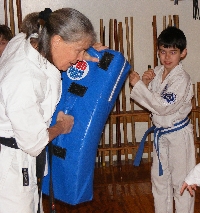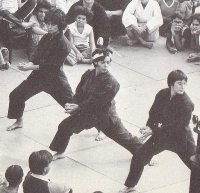2020 February
2018 December August June February
2017 December September June March
2016 November August June March
2015 December October July May February
2014 December October July April February
2013 December October August May February
2012 December September July April February
2011 December September July April February
from the March, 2009 issue of Kiai!
 |
Traditional Martial Arts in Today's World Kyoshi Sarah Ludden, Co-Executive Director and Head Instructor |
 |
One day, over a decade ago,
I realized that my karate practice and teaching, activities I deeply
loved, had in fact become my life’s work, the contribution I am making
to society. I had to ask: is this a good thing, a
righteous choice? Of what value are martial arts ––a military
science from the days of brutal hand to hand combat, swords and horses,
bandits and fiefdoms, samurai and zen training—in today’s
world? How and when does teaching karate become a progressive
force for peace and justice?
I looked to the historical roots of Seido karate for answers.
With the end of the feudal period and the transition to modern
democratic life, the Japanese military arts evolved into a physical
cultural practice. It was a valiant effort to preserve the
sophisticated but antiquated martial skills of the samurai, the
vigorous physical and mental training, and the values of bushido—
bravery, honor, respect for ancestors and lineage, truthfulness,
etiquette, self control and self sacrifice.
The Okinawans developed empty handed fighting systems to resist foreign
occupation and to defend their lives, land and honor.
Chinese martial arts history is interwoven with its healing arts; the
place to strike the body to injure or kill is a place to stimulate with
acupuncture or acupressure to heal. Lethal attacks and
effective defense can be seen in the flowing, meditative, health
restoring motions of tai chi. As the military use of chuan fa (generic term for Chinese martial practice) became outdated, the
personal self-defense and health and fitness function remained, thereby
preserving this unique strand of cultural history.
Martial Art Spreads to
the United States
Following the US involvement in World War II and later the
Korean War, servicemen
and women returned home with training in Asian martial arts.
Travel to the US from around the world, including Brazil, Southeast
Asia, Indonesia, and the Philippines produced martial arts schools in
immigrant communities, later spreading to other communities.
The American martial arts boom began.
Martial arts schools surfaced in countless neighborhoods, people
bringing their own perspectives, politics and ambitions to their
teaching. Kaicho Tadashi Nakamura, in 1976, created a new
style, Seido Karate, the “sincere way.” His goal was to offer
karate to the widest range of students, and viewed training primarily
as a vehicle to develop character and improve our ability to contribute
to society.
Roots in Social Justice Movements
The struggle for racial and sexual equality informed this next
generation of martial artists. Violence as a tool of racial
discrimination, and violence against women, sexual assault and the
repression of women culturally, were politicized. FIGHT BACK! was
a revolutionary statement. Women, including Nancy Lanoue,
co-director of Thousand Waves, sought training from martial arts
teachers, demanding to be taught, systematically extracting the
relevant techniques which could be used by a woman to resist an
assault.
Some women left their teachers with this rudimentary skill base,
connected with other women and collectivized their knowledge to develop
the first women’s self-defense curricula and trainings. The
National Women’s Martial Arts Federation, now over 33 years old, was
created during this time.
Over these last 30 years, we have studied the patterns of violence, the
forms of psychological, verbal and physical violence, the scope of
violence, from personal to interpersonal, from within the family to
international conflict. FIGHT BACK! is a complex notion,
demanding disciplined and multi-disciplinary analysis.
Rights and Responsibilities of Self-Defense
Not wanting to perpetuate the cycle of violence and revenge, we have
broadened our definition of self-defense to include non-violent
conflict resolution skills, boundary setting skills, the ability to
de-escalate a tense situation before it escalates into verbal or
physical violence, and anger management strategies. We have rights and responsibilities as self-defenders to stand up to injustice and do our part to stop
violence. Nancy Lanoue and Marie O’Brien, Director of Violence
Prevention Programs at Thousand Waves, have been leaders in this
important work nationally.
At Thousand Waves, we ask each karate student who is testing for
advanced brown belt, the last rank before black belt, to write an essay
explaining how their training is not violent, but is in fact a practice
which enhances our ability to move through the world non-violently.
Students have cited the development of self-confidence,
self-discipline, self-control, compassion, physical conditioning and
emotional healing. We practice in a social structure that
emphasizes community, respect and responsibility to self and others;
meditation enables us to withstand pressure and respond to stress
calmly; and we hone fighting skills to respond appropriately to
violence.
In sum, we gain the skills and courage to fight back, the skills and courage to NOT fight back, and the personal discipline to choose our response to violence appropriately.
This is the purpose of martial arts training in today’s world.
These are vital life skills, as important as first aid, CPR, sex and
health education, fire drills and financial planning. From feudal
Japan to 2009 Chicago…quite a journey—a military science transformed to
an art form, a health and fitness regime, a thoroughly modern violence
prevention curriculum.
Students Gain Discipline and Courage
At Thousand Waves, children experience the joy of “learning hard
things,” and discover that discipline is essential and rewarded, their
personal integrity is respected and that they have the responsibility
to be peacemakers in the world. Classes give members the
opportunity to develop cardiovascular fitness, strength, flexibility,
speed, coordination and endurance and offer well earned relief from the
pressures of work and family responsibilities—the blood flows, the body
sweats, the mind is engaged, and the student leaves spiritually
restored.
The training is exhilarating— feeling one’s power on the heavy bag or
when breaking a board is life altering. It is the power to
accomplish, succeed in life, overcome hardship, heal from abuse, take
on life’s challenges and set the bar high.
Teaching Traditional Martial Arts Today
Martial training is facing fear, taking responsibility for our
shortcomings and committing to grow and change. As a martial arts
teacher I examine the craft of teaching, the methodology of
transmitting the specific skills of Seido karate and self-defense, and
am confident we are doing a good job in this arena. What is more
complicated is deciding what is needed to promote the personal discipline,
the reflex training and conditioning of spirit that is needed to
“choose appropriately” when confronted with violence. This unique
element distinguishes karate from yoga, dance class, and functional
fitness training.
We must create an atmosphere that facilitates concentration and focus,
inspiring courage to face fear, dedication to push ourselves and not
accept excuses for failed effort. Every student has the right to reach
their potential so we must challenge each student, and challenge them
appropriately. To care as a teacher is to be strict and
demanding, to expose students to heights they had not imagined being
able to climb, and convincing them they can, if they work hard.
To communicate love and gentleness, respect and admiration, and expect
the most. And being exemplary students ourselves, training hard,
learning and growing, expressing humility and gratitude.
I believe we are on the right path, promoting peace and justice,
healing and empowerment. The historical roots of our martial arts
provide an edifying foundation and contemporary realities provide focus
and direction. I am grateful to be a part of Thousand Waves and
play a role in helping the Center fulfill its mission of promoting
health and fitness, empowerment and violence prevention and am deeply
indebted to the intelligent and brave leadership of Jun Shihan Nancy
and Kaicho Nakamura. Osu!
